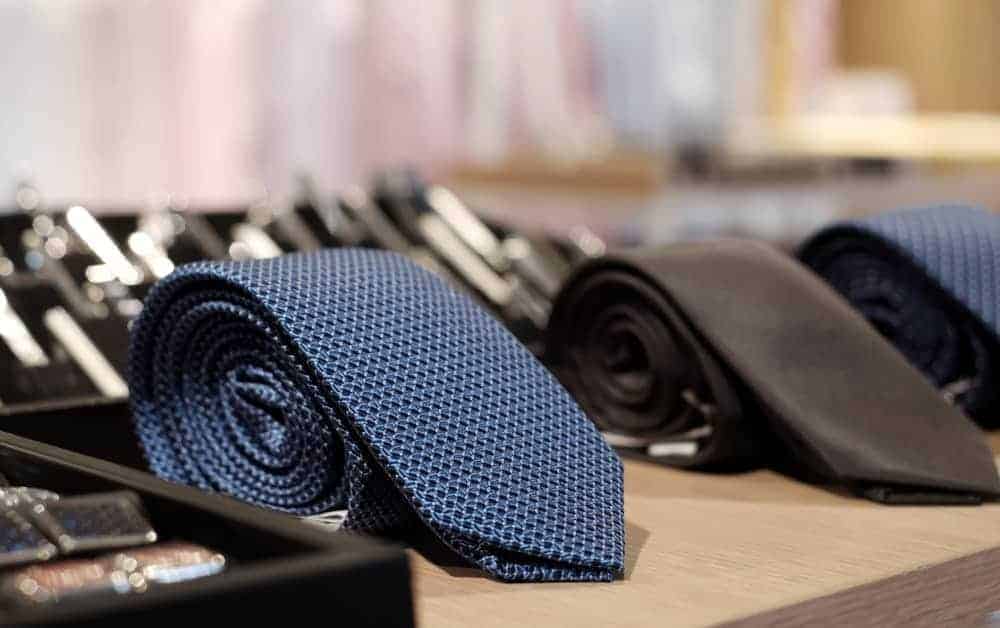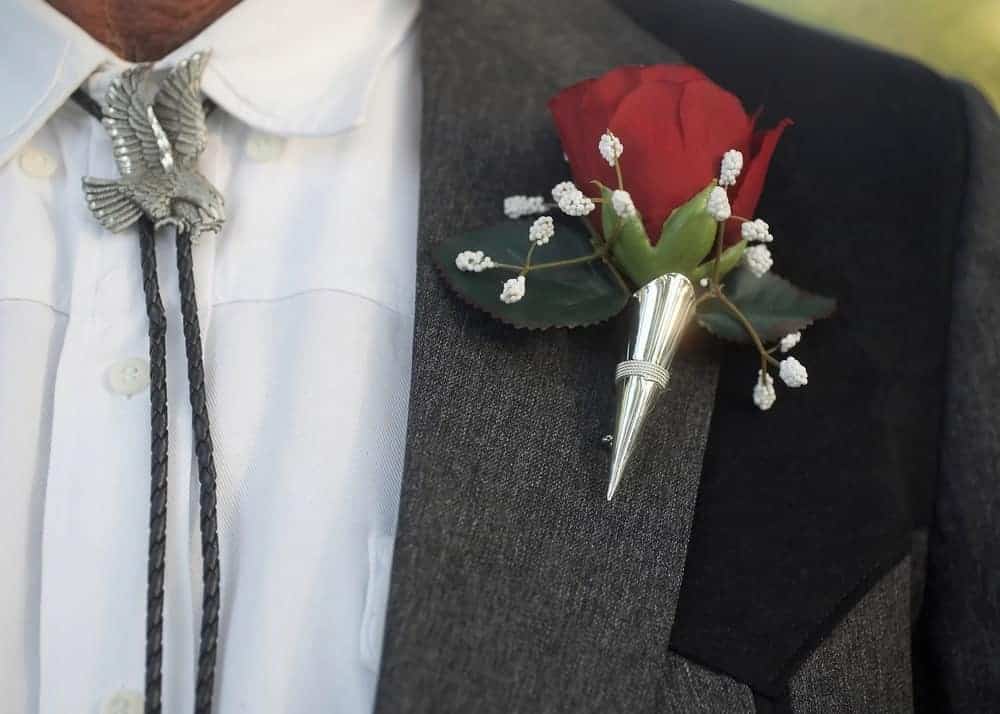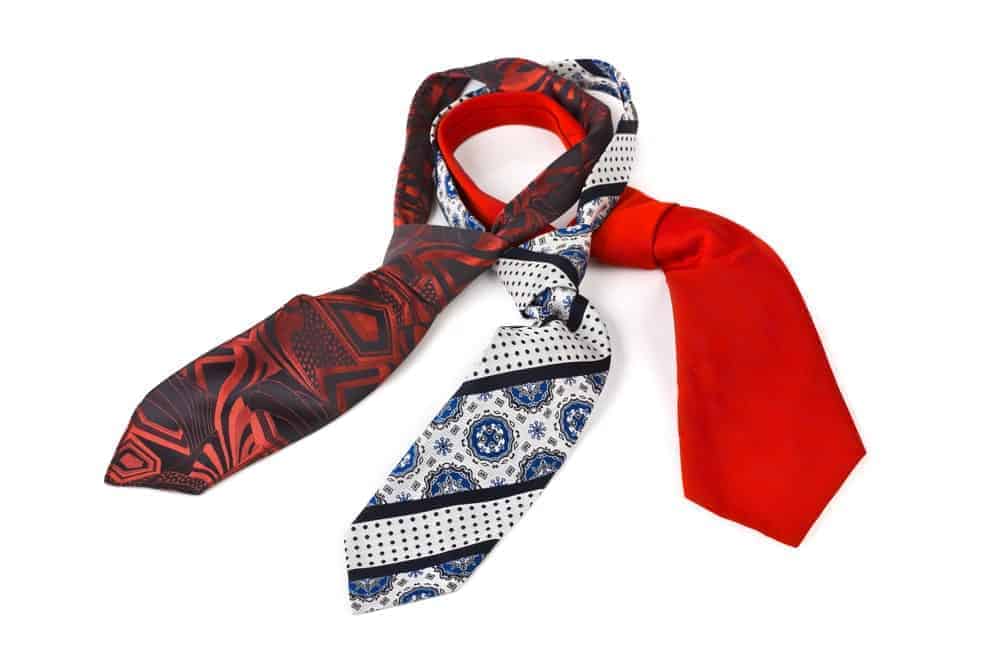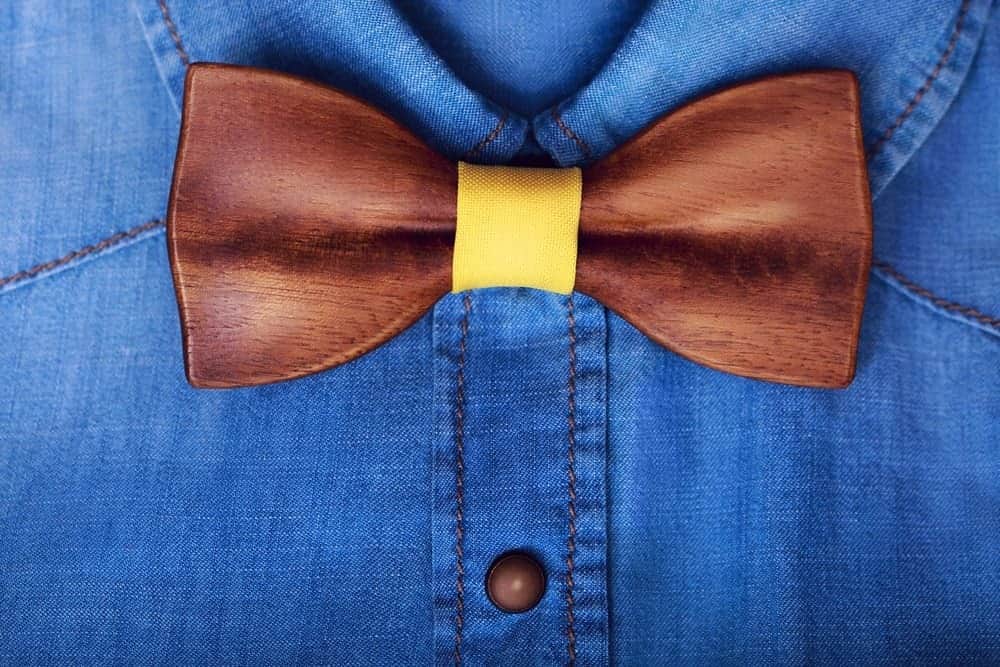Here's an epic list of the different types of ties you can wear plus a detailed tie history and quick list of the different parts of a tie. AKA, this is your ultimate tie guide.
A necktie is a long piece of cloth that is usually worn by men to adorn their suits or formal clothes in a formal setting.
The necktie can also be worn by women for the same reason. Throughout the years there have been several different neckties for several different occasions.
Neckties have also become an essential part of formal office wear in some settings, and some professions consider a suit and tie to be the unofficial uniform. Neckties are usually worn over the top button or the collar button of a shirt, and they rest on the button and are sheltered under the collar.
Related: Types of Shirt Collars | Types of Suits
Anatomy of Ties
Neckties are usually 3.5 to 3.75 inches wide and 52 to 58 inches long. Ties are traditionally made of silk but are available in other materials as well. The typical parts of a necktie are:
- The Shell: Also known as the envelope. It is the outermost fabric of a tie.
- The Seam: It is located about halfway along the length. Neckties usually consist of 3 to 4 separate pieces of fabric sewn together. The seam is the point of their stitching.
- The Neck: The midsection of a necktie is called the neck.
- The Interlining: The fabric enclosed within the folds of a tie. It is what gives a necktie its shape, bulk, and weight.
- The Rolled Edge: The edge of a necktie is rolled to provide fullness to the edge.
- The Tail: The narrow end of a tie that that hangs behind the larger end when the tie is knotted is called the tail.
- The Bar Tack: A heavy stitch that holds both sides of the necktie together. It also maintains the shape of the necktie.
- The Blade: The main, wide lower part of a tie.
- The Tipping: The fabric sown under the tail and tip of the tie.
- The Margin: Margin is the area between the edge of the tie blade and the tipping.
- The Hem: Hem is a finishing stitch connecting the shell to the tipping.
- The Slip Stitch: It holds the two overlapping sides of a necktie with the help of single stitch that runs across the length.
Chart: Top 10 Types of Ties
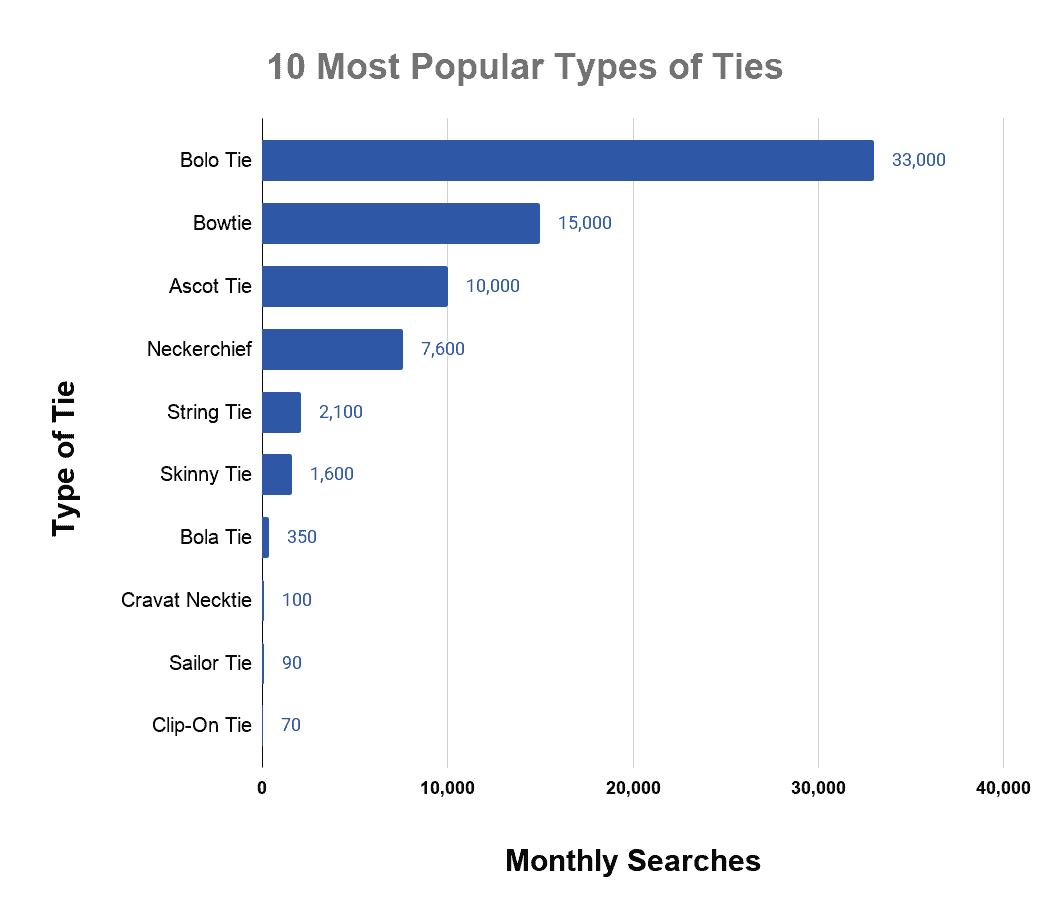
All Types of Ties
Apron Necktie
The apron necktie is the most common of all neckties. It is a long piece of cloth that is pointed at both ends, one of which is larger and wider than the other. The tie can be tied into several different knots, some of which are considered more common or more acceptable in formal settings than others. These styles include the Windsor or the Half-Windsor knot, popularized by the Duke of Windsor in the 1920s, and the Persian knot or the simple four in hand knot. Apron Neckties can come in several shapes and sizes, and they are usually worn with formal suits.
Ascot Tie
The Ascot necktie is worn under the dress shirt but over the undershirt. It covers a significant portion of the throat line below the chin and is knotted several times. It is worn looped over and is usually held in place with a scarf pin. Ascot ties generally sport more colorful designs than Apron neckties and are considered luxury wear, not suitable for workspaces.
Bowtie
Bowties are symmetrical ties, which are much smaller than neckties. They are narrow in the middle and wide at both ends. They are knotted in a way that they form bows with a small knot in the middle. They are worn at highly formal events like formal dinners, ceremonies, and celebrations. They are usually worn with tuxedos.
The bowtie can be a fun alternative to the necktie and can be used in a variety of settings from galas to balls to cocktail parties that require everyday wear. It can be paired with a seersucker suit in the Southern states.
Bolo/Bola Tie
A Bolo or Bola tie is a necktie that is made of a piece of cord or braided leather with metal tips at both ends. It usually has a metal or plastic clasp that secures it. It is also worn in a knot beneath the collar and covers the collar button. These ties are usually considered as jewelry items and are widely available with luxury clasps and pins. Bola ties can be made with bottle openers, refrigerator magnets, valuable coins, clips, etc. They are usually considered as a casual or informal item that is to be worn at celebratory occasions and not at formal meetings.
However, since the invention of the Bola tie in the 1940s, the stigma surrounding wearing it at formal occasions has subsided, and it is now considered more or less formal wear. It became very popular in the 1970s when in 1971 it became the official neckwear of Arizona and New Mexico and Texas. The latter two have signed laws making the neckwear official for their states as well. They have been worn by baby boomers that like gold panning, and has even become work appropriate up north of the United States.
Cravat Necktie
A Cravat is a necktie that is an ancestor or forerunner of the modern necktie and bowtie. It was inherited from the military from members that wore it during the 17th century. It is a neckband more than a tie and covers the entire neck. It can be made from cloth that can be wrapped around the neck or fashioned into a bowtie. However, the Cravat was usually kept plain and worn more as an ornament or sign of opulence rather than a formal uniform of any sort. It was reserved for kings and generals. It is very similar in appearance to the Ascot.
Sailor Tie
The sailor tie grew out of the habit of sailors to wear their scarves or handkerchiefs in a knot. It is a scarf or black silk handkerchief that has been folded diagonally and is worn under the sailor collar. It is either tied in a sailor knot or pulled in through a strap of a blouse. It is not a requirement of the sailor uniform but has become associated with sailors due to its constant feature in musicals and advertisements as well as cartoons.
String Tie
The string tie is a necktie that is no more than an inch wide and is often black. It is worn in the style of a bow tie, but the opposite ends of the tie are left hanging much lower and drop down to the lapel of the suit in some cases. It is also known by several other names such as the Southern Colonel tie, the Sherriff’s tie, and the Bootlace tie. It is most popularly featured in the KFC logo as the style of bowtie worn by Colonel Sanders; the original founder of the fried chicken recipe.
7-Fold Tie
A Seven-Fold tie is a very thin and unlined tie that is made from an outer fabric that goes through seven folds. It can go over seven folds as well under some conditions. This is why there is no need for lining; It has an uncharacteristically thick finish and feels, compared to that of a regular tie.
The seven-fold tie is a laborious piece of clothing to make and requires three and a half hours to make, Since it is so thick and uses so much fabric and effort to make, it is a relatively rare tie.
Clip-on Tie
A clip-on tie can be a necktie or a bowtie that has been pre-tie and just has a hook or a clip for you to attach it to your shirt collar. This is a type of tie that you can wear if you don’t want to make the effort of dressing up and tying the perfect knot. In the case of bowties, there may be a band around the neck that is fastened with a hook and eye.
Many people also use the clip-on tie because the normal necktie irritates them, and some use them out of necessity because they’re no good, or ill-equipped to tie ties. Some people with disabilities also wear them for ease. Some security guards also find it difficult to put on a necktie and just go with the clip-on.
Kipper Tie
The Kipper tie is a tie that is very wide on one end and very thin on the other. The tie is usually designed to be visually loud and bears garish colors and patterns. These types of neckties became common and fashionable during the 1940s and were considered part of a bold look worn by World War II veterans. They were also considered statements against the austerity measures instituted during wartime.
Kipper ties made a comeback during the 1960s and 70s, and designer Michael Fish also designed a Kipper Tie in 1966 out of his establishment in Piccadilly Circus. It became a sensation in the mid-1990s as well when the 1970s fashion came back for a time.
Skinny Tie
A skinny tie is a necktie with its principal end much thinner than usual. It measures near 1.5 to 2.5 inches rather than the full 4 to 4.5 inches that a regular tie front end measures. Skinny neckwear is highly fashionable for casual occasions, but they are much less suitable for formal events and office settings. Skinny ties usually go with the hipster brand of fashion and don’t fit into the more classic or traditional settings of sartorial sensibility.
Slim or skinny ties have usually been known to exhibit new age looks and fashion rather than old school necktie sensibilities. If you are going to an interview for a law firm or to a business meeting, then wearing a skinny tie isn’t appropriate. However, if you are going to a press junket or to a product launch or a party after an awards show, then wearing a skinny tie is much more appropriate and fashionable.
The skinny necktie became popular during the 1950s and 1960s when bands such as The Beatles began to wear them while performing on stage. They caused a sensation, and the look began to be mimicked by young boys looking to impress onlookers that mostly happened to be female.
Skinny ties can also be worn on jeans for a stylish, but edgy look. Not everyone can pull that look off so do be careful.
Western Bow-Tie
Western bow-ties are a variation of standard bow-ties. These are quite popular in the southwest. However, for other regions, it may be too casual and inappropriate for any formal or official wear.
Hunting Stock Tie
Hunting stock ties are worn by equestrians when they are riding in a show ring hunt field. They are worn by folding over once to fill the neckline of a jacket. The two ends are joined together with the help of decorative pins.
Up Cycle Fashion Neckwear
Up cycle fashion neckwear is worn by women and is usually more decorative and colorful as compared to traditional men’s ties. It is usually made out of different types of fabric and is decorated by different patterns and designs. It has leather, stone, or button ornaments and is usually knotted using the traditional way. There are other types of knots that do reflect the season or the colors that you are trying to complement, but usually up cycle fashion neckwear is worn in a traditional way.
This type of neckwear became popular during the 1960s and 70s and became part of the usual attire of women in the workplace, especially for secretaries and stenographers, etc. The Neckwear worn today is usually made of recycled fabric and sports a variety of designs and patterns depending on the season and the latest fashions. They are still usually worn by women over tops and pantsuits as well as shirts. They are made to complement almost every color and are treated as luxury items in some cases.
Neckerchief
The neckerchief is an overlooked option in neckwear. It is simply a variation of the scarf or handkerchief that you can tie around your neck. Different from the sailor’s tie mentioned above, this is worn by men of all professions and walks of life and can be made through a makeshift handkerchief or scarf. It can be worn in a traditional knot and can be as tight or as loose as you desire.
It is usually worn during informal events and serves as an accessory to casual wear. Therefore, it is not appropriate to be worn as part of formal wear. It is also worn by boy scouts and rangers as an identifier.
History of Neckties
Neckties originated in the 17th century during the war in France that lasted for 30 years. During this war, Croatian soldiers were hired by King Louis XIII to take part in combat. These soldiers used to tie a piece of cloth around their necks as a part of their uniform. Back then, this piece of cloth served the purpose of being tied around the jackets of the soldiers. King Louis XIII liked it so much that he made the accessory a mandatory item for all Royal gatherings. He named these neck piece La Cravate to honor the Croatian soldiers.
Ever since the 17th century, neckties have undergone many subtle changes. In order to understand how the modern tie came to be, we have chronicled their history by decade.
1900-1909:
During this time, neckties were a mandatory clothing accessory for men. The most common type of necktie was cravat. The difference was in the way the cravat was tied. Two decades before the start of the 20th century, the four-in-hand knot was invented, which is still the most common type of tie knots today. Bow-ties and ascots were quite popular during this time as well.
1910-1919:
Men’s fashion became casual during this period. More emphasis was laid on comfort, fit, and functionality of the clothes. By the end of this decade, the ties started resembling the ties that are worn today.
1920-1929:
A significant development was seen in men’s ties during this decade. Tie makers in New York started to cut fabric for ties in a new way which made the tie spring back to its original shape after every wear. Because of this development, many new knots were created. Ties became a choice for many people because bow ties were limited and reserved for formal evenings and black tie functions.
1930-1939:
During this phase, neckties became wider and had bold patterns on the ties were worn a bit shorter than how they are worn today.
1940-1949:
There were no exciting developments in neckties during the early 1940s. After World War II ended, neckties became popular. The sense of liberation was evident in fashion. The ties became bolder in color and patterns.
1950-1959:
It was during this decade that the skinny ties emerged and gained popularity. This type of tie complimented tailored and more form-fitting clothes. Ties were made available in different materials.
1960-1979:
During this era, ties became extremely wide which were called the Kipper Tie. It was also during this decade that the Bolo Tie was created. It later went on to become the official neckwear of Arizona.
1980-1999:
The width of neckties became a bit consistent. The patterns were relatively bold and paisley.
2000-2009:
Ties became thinner and skinny ties became popular again.
2010-Onwards:
Ties are now available in numerous widths and lengths. It all comes down to what you choose to wear.
Why Wear A Necktie?
Most men are comfortable wearing casual dresses. Ties are underrated. A tie can have a significant impact on your overall persona and outlook. Below are a few reasons why you should wear a tie.
- Before anything, ties make you look good. Wearing a tie can make you look classy and raise the level of a basic lookup by several notches.
- Ties are a symbol of honor, order, and nobility. They have been like this since they originated in the 17th
- Ties are a signal of capability. Ties make you look smart and influential, even if you are not. Wearing a tie confidently will automatically make people perceive that you have influence and power.
- Ties help you look distinguished.
- Ties are a mark of professionalism. A person appearing for an interview in casual clothing will leave an entirely different impression than someone who appears wearing a tie. Even if you work in an office where the environment is causal, a tie can improve your presentation drastically.
- Wearing a tie indicates extra effort. It shows that you have gone an extra mile to look impressive. People are impressed if they know you have spent some time working on your look before meeting them.


